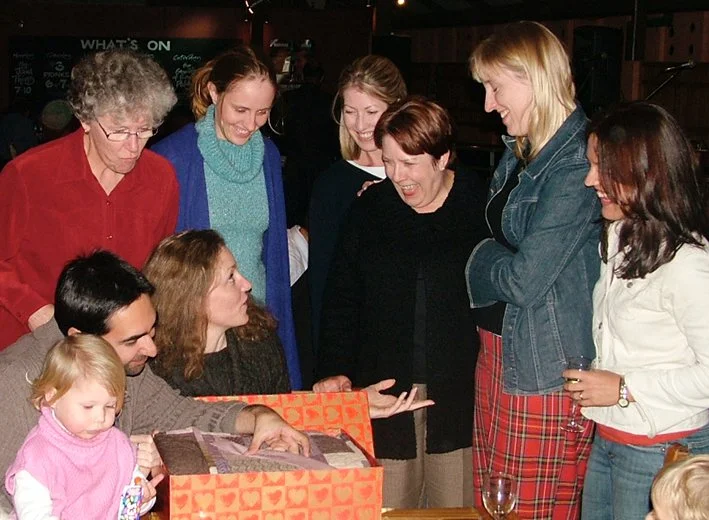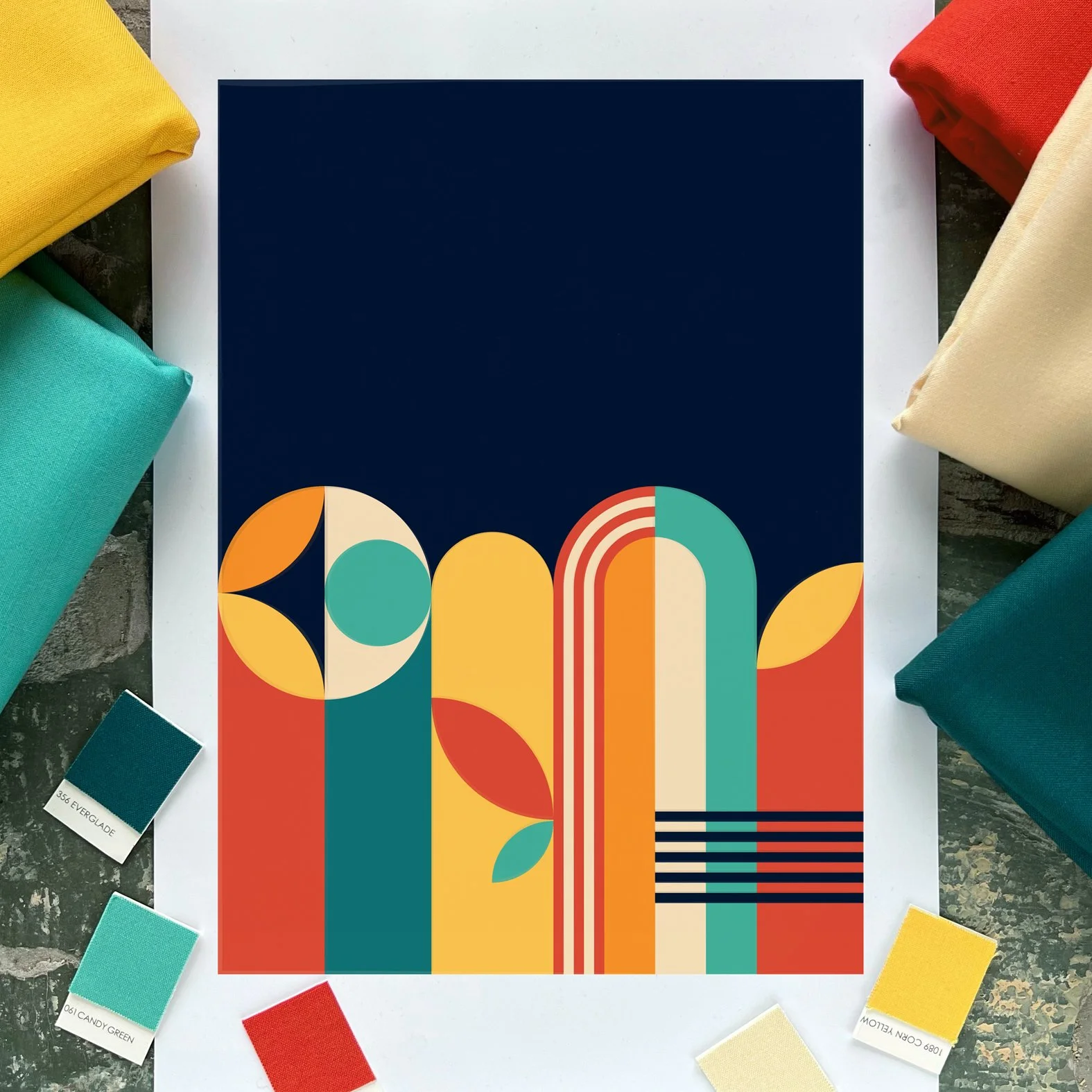Gifting a quilt that’s loved…
And not left in a cupboard
A couple of weekends ago I was on a trip away and made a detour through the town I grew up in to give Mum her Surfacing quilt. She’s so happy with it, and it suits her style better than I imagined. It got me thinking…
The Surfacing quilt in its forever home.
That’s not always how it goes.
I hear a lot of stories from quilters who have lovingly stitched something for a family member or friend, only to find it folded away in a cupboard, never to be seen again. Sometimes it’s because the recipient is “saving it for best” (which is heartbreaking in its own right), but more often than not, it just... wasn’t quite right for them.
And I get it. We all have patterns we’ve been dying to try. A colour combo that excites us. A quilt we want to make for the sake of making it. But when we’re giving, it’s worth switching the focus.
I approach quilt gifting in the same way I approach client work as a designer – by asking questions. The kind that help me understand not just what someone likes, but how they live. It’s not about losing the joy of making, but about giving your quilt the best possible chance of being loved.
Here are a few things I consider:
Is the recipient a quilt person?
It sounds harsh, but it’s a good question. Some people just aren’t into quilts. Maybe they live in a hot climate and never need a throw. Maybe they prefer minimalist interiors and see textiles as visual clutter. Maybe they just wouldn’t use one, no matter how beautiful it is.
Before you begin, think about how this person lives. Have you ever seen a quilt in their home? Do they curl up on the couch? Are they the type to treasure a handmade gift, or would they be quietly panicked by the responsibility of it?
If they’re not a quilt person, it might be better to channel your creative energy elsewhere.
What size suits?
It’s easy to default to throw-size, but size really does matter. Think about what would be most useful – after all use is what we’re aiming for. A throw quilt might be the perfect thing for an older person to use as a lap quilt or someone who likes to curl up on the couch with a good book, but a bed quilt might be a better option for a couple starting out who are trying to furnish an entire house.
If you're making something for a significant occasion and the cost of a bed quilt is a barrier, you could consider inviting others to contribute. That way, it becomes a meaningful group gift, and you're not carrying the full cost alone.
When I first started quilting, we made wedding quilts for family members. I not only roped family members in to help with cost, but also with sewing. Both my sister’s quilts are faded, and one is almost threadbare from use, and all the women in the family have fond memories of the process.
Gifting a quilt to my middle sister and her new husband.
If it's not the cost but the scale of making that feels unmanageable, think about whether a wall quilt could be a better fit. It can be just as meaningful, especially if the recipient has an interest in art and fills their home with decorative works.
What’s their style?
Not yours — theirs. This can be a tricky one, especially if their taste is completely different to yours. But it’s also where a bit of curiosity and Pinterest can really help. I start a Pinterest board each time I’m making a quilt for someone, but you could just as easily start a folder of pics on your phone or on Instagram. Stalking their social media to see what they like and save is also a great way to understand their style.
What kind of art or homewares do they have? Is their home more earthy, bold, neutral, bright, vintage, modern? If they’re big on neutrals, a primary-coloured improv quilt might be overwhelming. If they love colour and print, a neutral all-solids quilt might feel flat.
When I was making the Tall Poppy quilt, my sister-in-law insisted she didn’t really have a style, and I think a lot of us feel that way. When I visited her home however, I noticed artworks dotted throughout the house that all had a theme – bold, floral, folk-art style. Be curious.
Jen Hewett’s ‘Unruly Nature’ fabric range not only had the right vibe but also the right colours to match the bedroom.
What if it’s a surprise?
If you don’t want to ask outright, there are other ways. Let’s say it’s for a newlywed couple setting up their first home – you might say something like, “Oh, I loved moving into my first place and finally getting to decorate how I liked. What are your plans?” It gets the conversation going in a casual, open-ended way.
You can also co-opt mutual friends or family members to do a little reconnaissance for you – ideally someone who can describe colours, furniture and the overall feel of a space. Better yet, get them to take a few sneaky photos..
Mum did exactly that when we were planning a quilt for my aunt’s big birthday – taking a bunch of pics so we could get the colour palette just right.
What about a pattern and fabrics?
I’d never thought shapes were a big deal until someone I was making for said, “I don’t like triangles.” Message received.
Look at what they already live with. Sharp geometrics can feel clean and architectural – great for someone with a modernist streak. Curves often feel softer and more organic.
Fabric can also be a great prompt for a design, especially when using meaningful fabrics. When making a quilt for a friend’s significant birthday, I used fabrics she had actually collected for me on a trip to South America. By cutting them to bring out the pinks that I know she favours, I got a quilt that she loves as well as reminding her of her travels.
Getting the colours right
Possibly the most emotional element of all.
Start with what you know – and that’s not their wardrobe. Plenty of people wear colours they’d never decorate with, and vice versa. Favourite colours can be more helpful, but a home visit is best.
When making a quilt for my nephew, I started by talking with my sister about colours. They were in the middle of a renovation, and throughout the house she was using a very sustainable paint that came in quite a limited range. Sometimes these limitations can really help you focus your approach. She sent me the link to the swatches she was using, and knowing my nephew likes bold, bright colours (maybe he takes after a certain aunt?) it was immediately obvious which part of the broader range I would use, including his favourite orange, of course – and so the Laneways quilt was born.
The design for the Laneways quilt was approved by my nephew before making.
Once you have your ideas together and you’ve shortlisted patterns and colours it can be worth sharing those ideas with someone else close to the person you’re making for (if you can’t share it with them). Friends or family members can be great sounding boards. Talking through your rationale can help too – explaining you chose certain colours for a bed quilt because it matches a feature artwork in the room for instance. Listen to constructive feedback, but be willing to back yourself (and your research) too!
Even after going through this process, there are no guarantees, but you’ll have given yourself the best possible chance of nailing the perfect gift. I always say that I let go of the expectations for quilt the minute I hand it over. After all, I know there’s love in every stitch and there’s been joy in the process.






